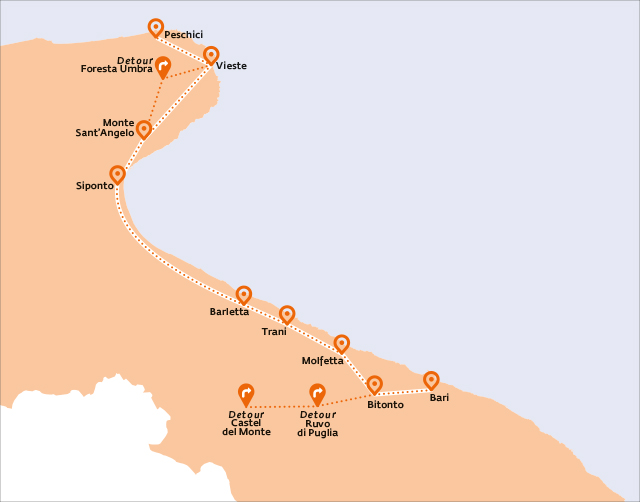
Kick off with some urban grit in Bari, Puglia’s largest city and main international gateway. Pay your respects to the city's patron saint in the Basilica of San Nicola, the last resting place of St Nicholas and a fine example of Puglian-Romanesque architecture. Then take some time to explore the labyrinthine alleyways and piazzas of the old town, Bari Vecchia, and check out the city’s fine Norman-Swabian castle and the beautiful Cathedral of San Sabino.
Wander the seafront and enjoy a meal of fresh-off-the-boat seafood at one of the city’s excellent trattorias. To round your stay off in style, take in an opera performance at the celebrated Teatro Petruzzelli.
Surrounded by endless swathes of olive groves, Bitonto is known locally for its excellent extra-virgin olive oil. However, it’s the town’s medieval core that makes a stop worthwhile. The headline act is the magnificent 12th-century Romanesque cathedral but you’ll also find an impressive 14th-century tower and a number of smaller medieval churches to refresh the spirit. Back on the coast, the colourful fishing port of Molfetta rarely draws the crowds of Puglia’s better-known towns but that merely adds to its charms.
Down by the waterfront, its historic centre is an atmospheric tangle of narrow lanes laid out in a ‘fishbone’ plan typical of the Norman age. Towering over the streets are the twin towers of the port-facing Duomo of San Corrado, reckoned to be Puglia’s largest Romanesque church. Apart from the cathedral, there are few must-see sights but it’s a real joy to stroll around the harbour and explore the skinny alleyways that weave back from the water to reveal balconies, hidden niches, and arches.
For a change of scenery, venture inland. Some 19 km west of Bitonto, Ruvo di Puglia merits a quick stop for its attractive old town and Romanesque-Gothic cathedral. Continuing westward and you’ll come to Castel del Monte, Puglia’s most celebrated castle. Lording it over the green landscape of the Murge, this iconic landmark, built by the 13th-century Swabian emperor Frederick II, is an unforgettable sight with its enigmatic octagonal form.

Nicknamed the ‘Pearl of Puglia’, Trani has a sophisticated feel, particularly in summer when holiday visitors pack the bars on the picturesque marina. This is the place to promenade and watch the boats, while the historic centre is ideal for a leisurely stroll with its glossy limestone streets, historic synagogues and faded palazzos. The town’s crowning glory is its graceful pink-stone cathedral on the seafront.

Barletta’s crusading history is more exotic than the busy, modern-day town, though its historic centre is pretty enough and warrants exploration with its cathedral, 5m-high Colossus (depicting a figure thought to be the emperor Theodosius II) and Norman-Swabian castle. A short 9 km drive from town is the archaeological site of Canne della Battaglia where the Carthaginian general Hannibal famously defeated a Roman army in 216 BCE.
Another fine archaeological attraction is the Archaeological Park at Siponto near Manfredonia. This encompasses what’s left of the ancient port of Siponto, a city which was founded in about 194 BCE and grew to become an important religious centre before being abandoned after a series of earthquakes in the 13th century. Its main focus is a modern installation by artist Edoardo Tresoldi which recreates the structure of an underlying paleochristian church. Made out of wire mesh, it juxtaposes strikingly with the adjacent Romanesque Basilica of Santa Maria Maggiore. Once you've finished here, continue northeast to Monte Sant’Angelo. One of Italy’s most enduring pilgrimage sites, this remote hilltop town has been drawing visitors since the Archangel Michael supposedly appeared to the Bishop of Siponto in a local grotto. During the Middle Ages, the faithful would arrive on the Route of the Angel, a pilgrim trail which started in Mont-St-Michel in Normandy and passed through Rome en route to Puglia. The town’s main attraction is the UNESCO-listed Sanctuary of San Michele, a remarkable complex of Romanesque, Gothic and baroque buildings centred on the famous grotto. Etched bronze and silver doors open into the cave where a 16th-century statue of the archangel stands over St Michael’s footprint.


The last remnant of Puglia’s ancient forests, the UNESCO-listed Foresta Umbra extends across the Gargano’s hilly interior. Some 30 km north of Monte Sant’Angelo, it’s a wonderfully uncontaminated area where Aleppo pines, oaks, yews and beech trees thrive alongside up to 65 different types of orchids. Well-marked trails offer wonderful walking and mountain-biking – you can hire bikes and buy hiking maps at the small visitor centre in the heart of the forest.
Jutting off the Gargano’s easternmost promontory, Vieste is a handsome whitewashed town overlooking a lovely beach – a gleaming strip of sand flanked by sheer white cliffs and overshadowed by a towering 25m-high rock known as the Pizzomunno. It makes a great base for exploring the Gargano and striking out to nearby beaches: Spiaggia del Castello, Baia San Felice and Cala della Sanguinaria.
Further around the coast from Vieste, Peschici is another attractive town, sprawled across a clifftop above a long sandy beach. There’s a distinct Arabesque feel about its old town with its steeply-stacked white houses and tangled lanes. For an experience to remember, treat yourself to a sunset aperitif or seafood dinner by a trabucco (traditional fishing platform) on the waterfront.

BuyPuglia is the digital system tailored to suit your tourism business in Puglia. Our matching platform is an easy tool to explore meeting opportunities with Puglian suppliers and learn about their tourism &.. cultural products. BuyPuglia ranks buyers and sellers based on entered information. Shared interests are paired, helping plan effective meetings and delivering optimized supply &.. demand solutions.